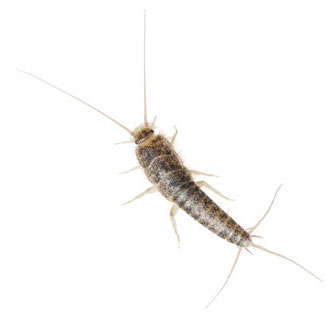Silverfish Seek Water But Do Not Swim
By Ray Novitske, Fairfax Master Gardener
Silverfish (Lepisma saccharina) are one of those insects with a cute exotic name. They get their name because of their silver color with a body covered in tiny glistening scales like fish. They are wingless and typically 1/3 inch in length and have two long antennae. They prefer concealed spaces and are nocturnal, coming out in the daylight only when disturbed.
 Silverfish like to hang out in cool, damp, dark places throughout the year, and are especially fond of basements, sinks, and bathrooms. They can also be found outdoors under rocks, leaf litter and damp caves, and around their favorite food sources. They love to eat materials high in starches such as glue, cellulose and paper found in wallpaper and book bindings. They are not dangerous to humans, and are only considered a pest. This is especially true in libraries and museums where paper and books are stored.
Silverfish like to hang out in cool, damp, dark places throughout the year, and are especially fond of basements, sinks, and bathrooms. They can also be found outdoors under rocks, leaf litter and damp caves, and around their favorite food sources. They love to eat materials high in starches such as glue, cellulose and paper found in wallpaper and book bindings. They are not dangerous to humans, and are only considered a pest. This is especially true in libraries and museums where paper and books are stored.
Silverfish lay eggs in groups of seven to twelve, and hatch as immature insects resembling miniature versions of the adults. Eggs hatch in about 20 days, but if temperatures are unfavorable, they may take up to 40 days. The insects molt several times until reaching adulthood, taking about one year, with their lifespan up to eight years.
These tough insects can go for long periods of time without food — up to an entire year. They have been known to cannibalize dead and injured insects when necessary. Although preferring damp areas, they can also survive long periods without water.
There are many ways to control silverfish — many of them without pesticides. The best way is to prevent them in the first place. Practice sanitary conditions such as eliminating stacks of old newspapers, magazines, books and fabrics. Reduce dampness by using dehumidifiers and removing standing water. Eliminate harborage and hiding places such as seams in interior walls and spaces between ceilings and walls. Seal up cracks and holes in areas where silverfish are found.
To eliminate them once they are found indoors, diatomaceous earth and silica dust work best. These dry materials injure the insects and cause them to lose moisture. Apply them as a dust in cracks and crevices or place them in walls and voids. Note that they are only effective if they remain dry.
Silverfish are only considered a nuisance insect. They are not directly harmful to us, but can be to our items in storage — items we value.
| References | |
| • | Featured Creatures, University of Florida |
| • | Silverfish: They are Silver, but They’re Not Fish, Laura Jesse, Iowa State University Extension & Outreach |
| • | Silverfish & Firebrats, Clemson Cooperative Extension |
| • | Silverfish, University of Minnesota Extension |
| • | Bristletails (Silverfish and Firebrats), Penn State Extension |
… updated 2023